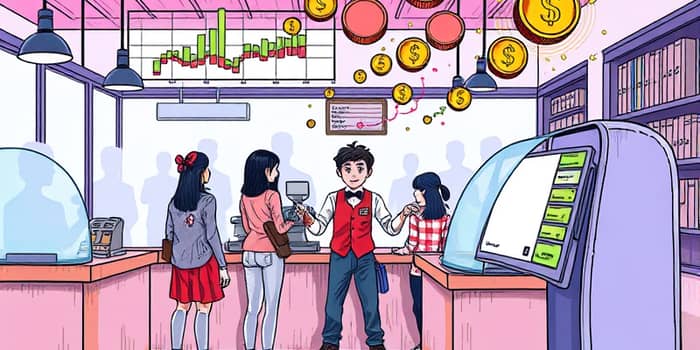
The consumer sector stands at a pivotal juncture where labor shortages are reshaping earnings across retail, foodservice, hospitality, and beyond. As 2025 advances, businesses large and small find themselves caught between robust demand and an ever-shrinking pool of available talent. This article examines how the interplay of workforce constraints, rising costs, and shifting consumer behaviors is rewriting the financial playbook for companies that define daily life.
Despite a steady unemployment rate of 4.1% and widespread wage gains, many operators describe deep unprecedented staffing challenges. From fast-casual chains in urban centers to family-owned diners in rural communities, the struggle to attract and retain qualified employees is forcing a fundamental rethink of how the consumer economy functions.
Across retail shelves and kitchen lines, the battle for reliable staff has never been more intense. Recent surveys show that 36% of foodservice operators are making workforce improvements their top priority heading into 2025. Even with unemployment levels near multi-year lows, recruiting efforts fall short as competing industries offer more flexible hours or higher signing bonuses.
These measures address persistent higher labor costs, but turnover remains stubbornly high. In many restaurants, unfilled shifts lead to reduced service windows and, on occasion, temporary closures. Retail stores, meanwhile, have cut back operating hours or limited in-store assistance during peak shopping periods when staff shortages overlap with consumer surges.
To counterbalance mounting payroll expenses, most operators have turned to pricing strategies. Fifty-eight percent of foodservice businesses have raised menu prices over the past year, passing labor cost increases onto customers. In tandem, 28% of outlets have streamlined their menus, removing underperforming items to simplify sourcing and preparation.
These changes reflect the ultimate double-edged sword of balancing cost recovery with customer satisfaction. While higher prices help sustain margins, they run the risk of alienating price-sensitive patrons and eroding brand loyalty. Many operators are experimenting with targeted price increases on high-demand items to minimize backlash.
The combination of wage gains and price hikes creates a fine balance between income and costs for households. On one hand, real wages are rising—fueling greater spending power. On the other, persistent price pressures curb purchases, especially in categories deemed non-essential.
In May 2025, personal consumption expenditures (PCE) declined by 0.3% month-over-month—the steepest drop this year. Durable goods spending took the brunt of the contraction; auto sales plunged 50% in a single month, and outlays on appliances and electronics fell sharply.
Meanwhile, service sectors remain resilient as consumers prioritize necessities. Whether it’s routine medical care, utility bills, or housing expenses, these dynamic resilient consumer sectors continue to see steady or rising revenue, softening the blow of goods-related spending pullbacks.
Spending patterns are diverging sharply across income brackets. Households in the top income tier, accounting for 56% of aggregate consumption, benefit from robust asset appreciation and wage growth. For them, incremental cost pressures are less disruptive.
Middle-income families, which represent roughly 30% of consumer spending, exhibit moderate sensitivity to price changes. They adjust by substituting brands or reducing discretionary items. In contrast, lower-income households face acute strain. Elevated food and energy prices consume a larger share of modest paychecks, leading many to delay non-essential purchases or downshift to lower-cost alternatives.
This stratification creates a two-speed recovery within the consumer economy, where sectors reliant on discretionary spending encounter headwinds, while essential services maintain momentum.
As labor remains scarce, businesses are increasingly turning to automation and digital tools to maintain service levels. From contactless checkout lanes to robot-assisted warehousing, technology is reshaping roles and workflows. However, widespread AI deployment is still in early stages, and concerns about workforce displacement persist.
These advancements underscore the pivotal role of technology in bridging workforce gaps without full reliance on human labor. Yet U.S. productivity growth remains sluggish at under 0.5%, compared to pre-pandemic levels near 1.5%. For meaningful improvements, human expertise and machine capabilities must operate in harmony.
At the same time, nonfarm payroll growth has decelerated to its slowest pace since before the pandemic. Even as hiring softens, real wages are rising, especially for entry-level positions—a testament to sustaining labor demand despite broader economic headwinds.
To thrive amid these structural shifts, leaders must embrace integrated solutions that address manpower shortages and evolving consumer expectations. Investing in employee development—through training programs, clear career pathways, and mental health support—can mitigate turnover and boost morale.
Cross-training team members ensures operational flexibility during peak traffic, while strategic alliances with local vocational institutes can cultivate a more robust talent pipeline. Employing dynamic pricing algorithms that respond to real-time data on demand and labor availability can help smooth revenue fluctuations without alienating customers.
By embedding feedback loops that capture insights from frontline staff and customers, companies can continuously refine processes. This approach fosters a culture of adaptability, ensuring that both service design and workforce planning remain aligned with shifting market realities.
Labor shortages represent a fundamental challenge for the consumer sector—one that will shape earnings and competitive dynamics well beyond the next quarter. Businesses that combine strategic investments in their people with judicious technology integration stand the best chance of maintaining profitability and customer loyalty.
In this era of transformation, agility, empathy, and innovation are paramount. By prioritizing both operational efficiency and the human element, organizations can secure their path forward and deliver long-term financial health outcomes despite uncertain labor markets.
References













